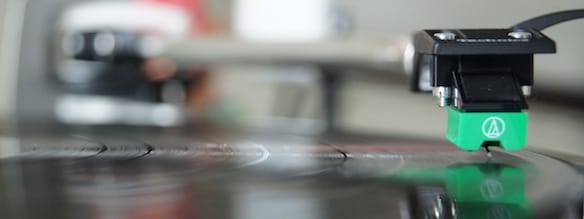
Image credit: Wikipedia.
Phonographic Cartridges
The cartridge on the tonearm of a turntable is the fulcrum around which the lever of sound quality pivots. The first magnetic cartridges to appear on the market featured an outsized heavy horseshoe magnet on the tonearm. To offset the erosion of the delicate grooves in a vinyl record caused by the weight, phonograph needles were designed of soft metal and ultimately disposable. After World War II, piezoelectric crystal and ceramic cartridges became standard, and the speed at which a record spun was slowed from 78rpm to 33-1/3 and 45rpm standards, with needle technology developing more permanence, using diamond and sapphire stylus tips.
As needle/stylus designs became smaller, lighter and more sensitive to the subtleties of the microgrooves etched into the records, the need for greater sophistication in the cartridge was inevitably addressed, and cartridges began to function as preamps.
Types of stereo cartridges
The Moving Magnet cartridge (MM) is a design wherein an electromagnetic field generates signals from the vibrations telegraphed through the needle by suspending the magnetized cantilevered end of the stylus (the cartridge end) between two electromagnetic coils. The vibrations of the stylus end moving between the coils thus create an electrical signal which can then be amplified.
The Moving Coil cartridge (MC) uses the same concept, generating a signal by electromagnetic fields, but turns it inside out: The cantilevered stylus end contains the coils which create fields with a separate magnet. Where the electrical output was significantly diminished in the MM design, the microscopic aspect of the coils on the stylus reduced the output current so drastically that preamplification was only nominally effective, and a step-up transformer was often employed in the output stage of the turntable signal path.
As we continue to ascend our way through degrees of sophistication and cost in our survey of cartridge designs, Bang and Olufsen produced a proprietary cartridge design know as Moving Micro Cross (MMC). This is a study of the Moving Iron variant of the MM cartridge, (wherein a ferrous mass on the stylus end is influenced by a separate magnet and coils,) splitting or coupling the stylus end into a cross-shaped broadcaster that creates fields (and thus a signal) using separate magnet and coils. This design was seen to isolate discreet stereo channels, where the other designs generate a certain latent signal from the adjacent to the intended channel.
Cost and availability
To search Google for “phono cartridges,” is to produce a screen of products that range from $60 (Grado Black1) to $12,000 (Goldfinger v2 by Clearaudio). Why such a disparity? Priceonomics will try to help consumers find the product to meet their needs in this contentious market.
The least expensive option is predictably a MM cartridge. Reading the product specifications, one realizes that 15% of the Black1 line meet higher performance criteria and are classified as the “green” series. A survey of user reviews shows generally positive response, with caveats, commonly indicated by the words, “but,” or “if not.” One might see a glowing review that states, “for the price.” Most listeners will be pleased with the sound of an “inexpensive” Grado cartridge, purchased for under $200.
The most expensive option initially seems to be a gold-plated version of another model, the Da Vinci. However, in investigating the performance and construction, one discovers the coils are wrapped in 24-carat gold. Most listeners in my current stable of peers would know certain trepidation in setting the stylus of a $12,000 cartridge down on any piece of vinyl. Not surprisingly, one sees a marked lack of caveats in the review of this device, and for our purposes this should serve as the ultimate cartridge, one made without limits. Technological developments have reduced the mass of cartridges and styli, and increased output stage signal current to compensate and ultimately create very low signal to noise ratios, resulting in audio performance between 10Hz and 100kHz, beyond the normal range of human hearing. Oddly, as the science of electromagnetic pickups becomes extremely sophisticated, many manufacturers are using wood in the cartridge design. Cardas, Grado and Clearaudio all produce cartridges in wood chasses.
Not unlike watching the controversial preference for turntables over CD players emerge in the audiophile community, reverting to wood in cartridge design may be seen as a step back. In the quest for fidelity in sound, however, the wood used in a cartridge design may be the optimum means of reproducing a sound that originated from a wooden instrument, a woodwind, piano, guitar or bass, for instance. While it might be argued that many of the sources of modern music are not wood, but actually digital in nature, their reproduction somehow seems to sound better with a bit of wood in the mix.



